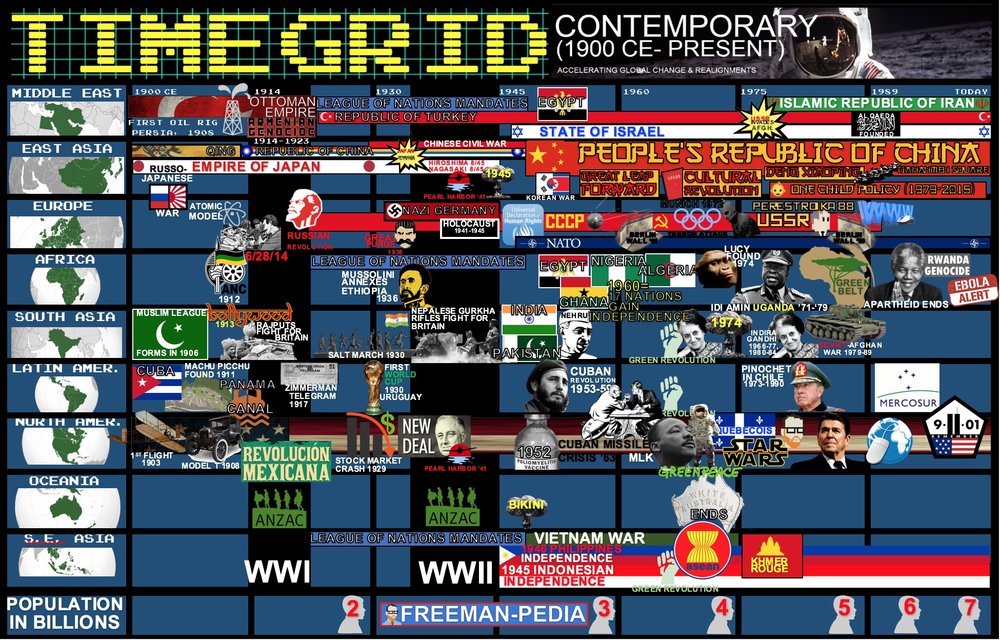Natalie Pineda
Harrison Burnside
AP World History: Modern 🌍
577 resourcesSee Units
AP World History Unit 9 on the Exam
Welcome to Unit 9, the final unit of AP world history 🎉! This unit covers the time period 1900—present, just like our last two units; unit 7 covered mainly wars in this time period, while unit 8 covered topics related to decolonization and proxy wars, like the Cold War. This unit is going to focus on ✨ Globalization ✨ and why our world is the way that it is!
This unit is worth about 8-10% of your multiple choice section, and it will probably be one part of SAQ #4, on a normal paper and pencil exam, along with units 7-8.
On AP Classroom, your teacher can unlock for you:
- A stimulus-based multiple choice practice Set with ~25 questions
- A free response practice set with 1 LEQ
- Another free response practice set with 2 SAQs
- SAQ 1 has a secondary source
- SAQ 2 has no source
Let’s look at some of the important events in Freemanpedia’s awesome timeline of the whole period 1900-present.

Image Courtesy of Freemanpedia.
A Note About “Modern History”
Since this is chronologically the last unit in APWH, a lot of the topics discussed in this unit might have happened during your lifetime or at least during your parents’ lifetimes. While keeping that in mind, we have to note that a lot of the topics that could be discussed in this unit are not fully “history” yet. Generally, any writings about the 21st century (especially secondary sources) are journalism (always written with human bias to further a purpose) and not historical pieces of writing—yet.
We’ve talked about this whole class through the historical thinking lenses of Causation, Comparison, and CCOT (Continuity and Change Over Time). We are still able to do that in this unit, but if you think about it, we are still living through the effects of things like 9/11, the War on Drugs, the War on Terror, and many more events that we will discuss in this unit. Due to that, it’s going to be hard for us to look into the future (unless you’re a super human 🤖) to determine the effects, continuity + change, or comparison of everything that’s happened from 1900 to the present.
Good thing we’ve already learned what’s happened in the past to still use those lenses!
Wait . . . What is Globalization?
Globalization is a multifaceted process that has been shaped by various forces and has had a range of impacts on people and societies around the world. At its core, globalization is the spread of ideas, products, and practices from one place to another, facilitated by advances in transportation, communication, and technology. This has led to a greater interconnectedness of the world's economies, cultures, and political systems. We'll see through this unit how globalization and its associated processes shaped much of the 20th and 21st (we made it!) centuries.
One of the earliest examples of globalization was the Columbian Exchange, which saw the exchange of plants, animals, and diseases between the Americas and the Old World. This process had significant environmental and cultural impacts, as new crops and animals were introduced to different parts of the world and indigenous peoples were exposed to new diseases. In more recent times, globalization has been shaped by the spread of capitalism and democracy, particularly during the Cold War period, when the United States and other Western powers sought to promote these ideologies around the globe. Globalization has had both positive and negative effects, with some people benefiting from increased economic opportunities and cultural exchange, while others have faced displacement and economic inequality.
This unit focuses on this idea of globalization with all 6 big ideas that we’ve used in this class (sometimes in the acronym of SPICE-T): Social, Political, Human-Environment Interaction, Cultural, Economic, and Technology.
Learning Objectives
After you finish this objective, you will be able to “explain how the development of new technologies changed the world from 1900 to present” (Courtesy of the College Board AP World History Modern 2020 CED). Make sure to keep that prompt in mind as you read this guide!
Some sections of this guide will focus more on new technologies versus environmental effects or economic systems, so try to keep these prompts in the back of your mind with the SPICE-T acronym above.
Main Events of Unit 9
1918-1919: Spanish Flu infects one-fifth of the world’s population. Deadlier than the Bubonic plague
1928: Alexander Fleming invented penicillin—antibiotics are born
1948: United Nations adopts the Universal Declaration of Human Rights
1950s: Green Revolution begins worldwide
1950s: Artificial birth control
1971: Greenpeace founded to protect the environment
1977: Green Belt Movement begins to combat deforestation
1995: World Trade Organization (WTO) formed
1997: Kyoto Protocol first agreement to reduce carbon emissions worldwide
2001: One day terrorist attacks on New York and Washington, D.C. by airplanes
2010s: “Arab Spring” revolutions overthrow dictators in North African countries
Browse Study Guides By Unit
🐎Unit 1 – The Global Tapestry, 1200-1450
🐫Unit 2 – Networks of Exchange, 1200-1450
🕌Unit 3 – Land-Based Empires, 1450-1750
🍕Unit 4 – Transoceanic Interactions, 1450-1750
✊🏽Unit 5 – Revolutions, 1750-1900
🚂Unit 6 – Consequences of Industrialization, 1750-1900
💣Unit 7 – Global Conflict, 1900-Present
🥶Unit 8 – Cold War & Decolonization, 1900-Present
✈️Unit 9 – Globalization, 1900-Present
✏️Frequently Asked Questions
🤔Exam Skills
👉🏼Subject Guides
📝AMSCO Notes

Fiveable
Resources
© 2025 Fiveable Inc. All rights reserved.